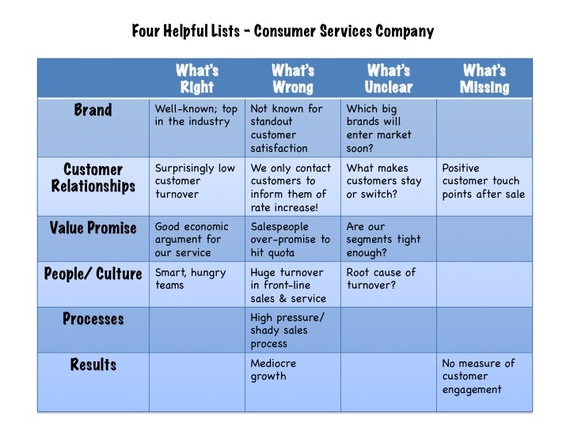Dear Change Agent,
Let's say you just took over a major business unit of a well-known consumer services company. You were brought in from outside the industry because you had a stellar history of creating healthy growth in other consumer-oriented services companies. Recent results have been mediocre. New competitors lurk around the corner, some of them bigger and badder than the company has ever faced.
You can see fundamental issues in the business - as fundamental as a casual attitude toward customers and the frontline employees who serve them. You know this because employee turnover at key frontline sales and service positions is through the roof. Maybe these symptoms are normal for this industry, but they're not normal for you.
You've been in your role for 30-60 days. You've gotten out in the field and seen first-hand what's going on with customers and employees. You've started collecting people to go along with your observations. You've sorted your insights into what's right, wrong, unclear, and missing about this organization.
Maybe your analysis looks something like this.
It's time to plan some action. But not any old action. Anyone can get busy. The relentless pressure you'll feel to DO SOMETHING will tempt you to jump into the busy-ness pit. Stop. Think.
Look especially for high leverage change opportunities, those places where you can push a little and get a lot of result. Here's what to look for:
- Push Levers, Not Rocks - Look for initiatives where focused effort on a relative few people, processes, or customers will touch many others. For instance, if your problem is improving how your sales organization interacts with customers, it will be tempting to focus energy on training front-line salespeople. That's pushing a very large rock uphill and probably the wrong place to start. Instead, ask yourself where the high-leverage few are. Usually that's going after sales managers or opinion leaders in the sales organization.
- Find Double-sided Initiatives - You're new into a culture with unwritten rules on how things run and what matters. If you want your ideas to be accepted, look for initiatives that can be positioned in at least two ways - to appeal to the existing cultural norms and to drive the organization toward the new cultural rules that you want to instill. So if the existing culture is cost and numbers driven and you want to foster a customer-obsessed culture, look for initiatives that can be positioned as reducing costs to your corporate colleagues while you emphasize the impact on customers to your own team. Avoid if possible single-sided moves that only play to the existing culture or the desired culture. If you completely conform to the current culture, you lose your edge for change. If you ignore the current culture in the zealous pursuit of change, it's only a matter of time before the organization spits you out.
- Select Symbolic Initiatives - Look for efforts around which you can wrap your change story. So if you're trying to change the culture from being casual toward customers to being customer-obsessed - and you've chosen your sales leaders as the leverage point - be ready to explain the initiative in terms of how it supports that change and why that change is important. The argument for driving a customer referral program could go something like this:
"Delighting customers isn't just a feel-good thing to do. It's the smartest way for us to run our business and to protect ourselves from powerful new entrants to our market."
"While our salespeople are the ones who most directly touch customers, our leaders are the ones who create an environment that drives how salespeople think and act. It's our job as leaders to make selling easier over time and there's no better way to do that than to get customers spreading the love."
"We're going to invest in and measure an initiative to help salespeople generate and track leads from referrals. But we're going to deliver this program entirely through our sales leaders because you are the ones to make this happen."
Observe. Diagnose. Select. Act. You're on your way.


